Archives
You are currently viewing archive for June 2011
|
June 27, 2011 08:14:50
Posted By DelvecchioRC
|
1930's (Carroll & VanBrunt St.s - looking up to Hicks Street) St. Stephen's Roof can be seen in the upper left side of the photo.
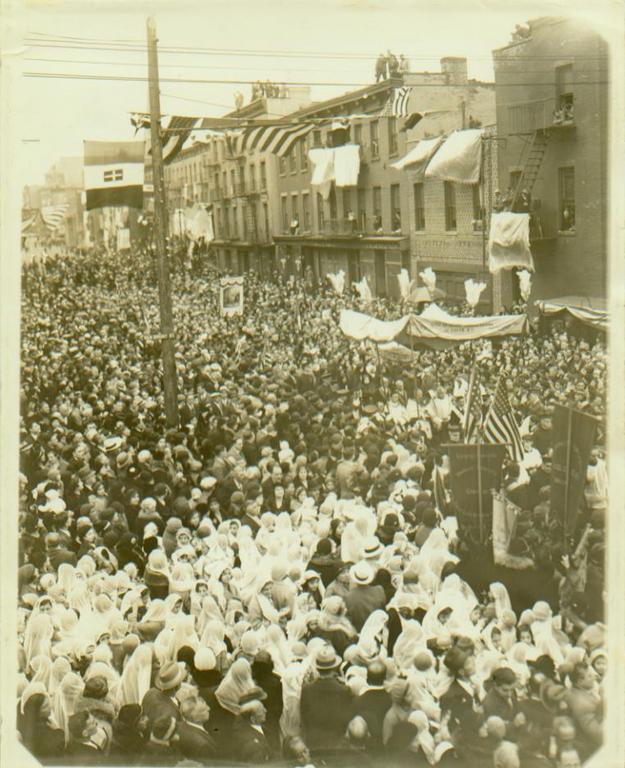
1950's (Msgr. Delvecchio on the steps of the church - after reconsturction of Church building)
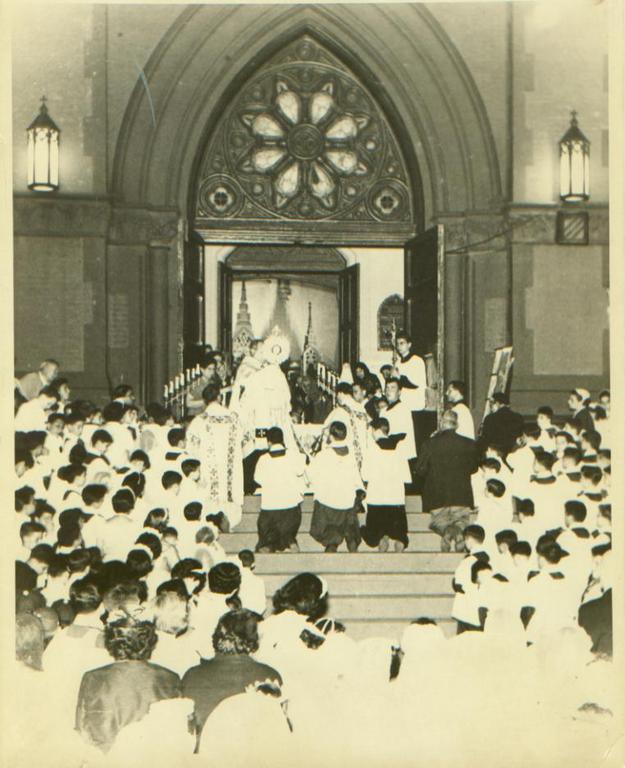
2002
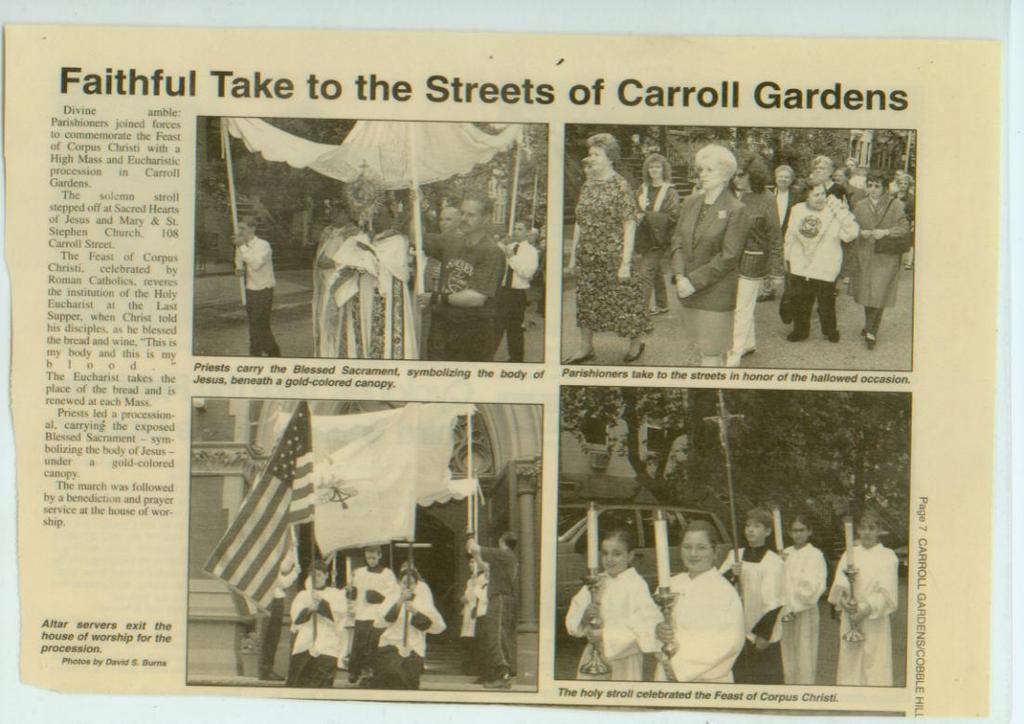
|
|
June 24, 2011 08:32:08
Posted By DelvecchioRC
|
Photo of Corpus Christi Procession from Sacred Hearts of Jesus and Mary PArish in the 1930's on Vanbrunt and Union Streets
The celebration of Corpus Christi became widespread only after both St. Juliana and Bishop Robert de Thorete had died. In 1263 Pope Urban IV investigated claims of a Eucharistic miracle at Bolsena, in which a consecrated host began to bleed. In 1264 he issued the papal bull Transiturus de hoc mundo in which Corpus Christi was made a feast throughout the entire Latin Rite. This was the very first papally sanctioned universal feast in the history of the Latin Rite.
A new liturgy for the feast was composed by St. Thomas Aquinas. This liturgy has come to be used not only on the Feast of Corpus Christi itself but also throughout the liturgical year at events related to the Blessed Sacrament. The hymn Aquinas composed for Vespers of Corpus Christi, Pange Lingua, is also used on Holy (Maundy) Thursday during the procession of the Blessed Sacrament to the altar of repose. The last two verses of Pange Lingua are also used as a separate hymn, Tantum Ergo, which is sung at Benediction of the Blessed Sacrament. O Salutaris Hostia, another hymn sung at Benediction of the Blessed Sacrament, comprises the last two verses of Verbum Supernum Prodiens, Aquinas' hymn for Lauds of Corpus Christi. Aquinas also composed the propers for the Mass of Corpus Christi, including the sequence Lauda Sion Salvatorem. The epistle reading for the Mass was taken from Paul's First Epistle to the Corinthians (1 Corinthians 11:23-29), and the Gospel reading was taken from the Gospel of John (John 6:56-59).
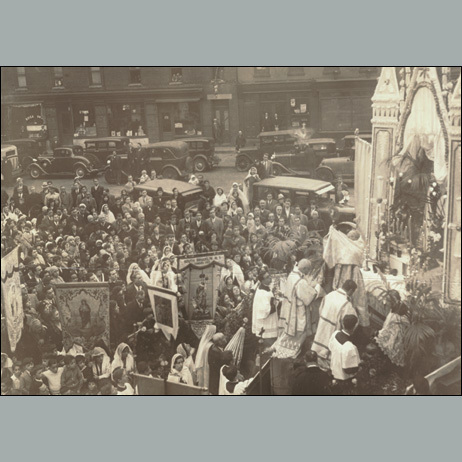
Corpus Christi
|
Categories:
Events,
History
|
June 24, 2011 08:19:06
Posted By DelvecchioRC
|
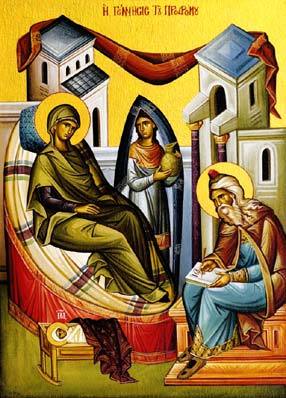
The day of a Saint's death is usually celebrated as his or her feast day, but Jesus, the Virgin Mary and Saint John the Baptist, while not being exceptions to this rule, also have feast days that celebrate their earthly birth. The reason is that St. John (Lk 1:15), like Jeremiah (Jer 1:5) and the Blessed Virgin, was purified from original sin before his very birth (in Catholic doctrine), though not in the instant of conception as in the latter case.
The Nativity of St John the Baptist is one of the oldest festivals of the Christian church, being listed by the Council of Agde in 506 as one of that region's principal festivals, where it was a day of rest and, like Christmas, was celebrated with three Masses: a vigil, at dawn, and at midday.
The Nativity of St John the Baptist on June 24 comes three months after the celebration on March 25 of the Annunciation, when the Archangel Gabriel told Our Lady that her cousin Elizabeth was in her sixth month of pregnancy, and six months before the Christmas celebration of the birth of Jesus. The purpose of these festivals is not to celebrate the exact dates of these events, but simply to commemorate them in an interlinking way.
Christians have long interpreted the life of John the Baptist as a preparation for the coming of Jesus Christ, and the circumstances of his birth, as recorded in the New Testament, are miraculous. The sole biblical account of birth of John the Baptist comes from the Gospel of Luke. John’s parents, Zechariah or Zachary — a Jewish priest — and Elizabeth, were without children and both were beyond the age of child-bearing. During Zechariah's rotation to serve in the Temple in Jerusalem, he was chosen by lot to offer incense at the Golden Altar in the Holy Place. The Archangel Gabriel appeared to him and announced that he and his wife would give birth to a child, and that they should name him John. However, because Zechariah did not believe the message of Gabriel, he was rendered speechless until the time of John's birth; at that time, his relatives wanted to name the child after his father, and Zechariah wrote, "His name is John" and could speak (Luke 1:5-25; 1:57-66). Following Zechariah's obedience to the command of God, he was given the gift of prophecy, and foretold the future ministry of John (Luke 1:67-79).
At the Annunciation, when the Archangel Gabriel appeared to the Virgin Mary to inform her that she would conceive of the Holy Ghost Jesus, he also informed her that Elizabeth, her cousin, was already six months pregnant (Luke 1:36). Mary then journeyed to visit Elizabeth. Luke’s Gospel recounts that the baby “leapt” in Elizabeth’s womb at the greeting of Mary (Luke 1:44). This is interpreted by Christians as John's first act of prophecy.
|
|
June 13, 2011 07:41:39
Posted By DelvecchioRC
|
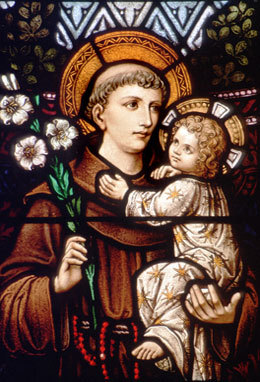
Born in Lisbon in A.D. 1195, St. Anthony, né Ferdinand, was the son of noble, God-fearing parents. He received a good education, and, at the age of fifteen, joined the Canons Regular of St. Augustine which whom he studied Sacred Scripture and the writings of the Fathers. At around the age of 25, he became inspired by the Franciscans martyred in Morocco and decided to join their Order, taking the name "Anthony."
Illness prevented his going to Morocco, so he spent some time in Sicily, in Assisi, and then in Montepaolo his public life began: during the ordination of a group of Franciscan and Dominican friars, it was discovered that no one had been appointed to preach. The superior turned to the Dominicans first because they are the "Order of Preachers," but all declined, saying they were not prepared. So St. Anthony stepped up -- and began to teach so beautifully that word of his talents reached the ears of St. Francis, who blessed his work.
St. Anthony taught at Bologna, Montpellier, and Toulouse, but it was as a fearless orator (he became known as the "Hammer of the Heretics") and a miracle worker that he is most reknowned.
St. Anthony, as a Franciscan, was also famous for helping the poor. At his encouragement, Padua passed a law in 1231 to help debtors who couldn't pay their debts.
St. Anthony died in Arcella, strengthened by an apparition of Our Lord and in the "odor of sanctity," at age thirty-six on 13 June, 1231. After he died, he announced his own death to Abbot Thomas Gallo by appearing to him. His death was also announced to the citizens of Padua by a troop of children, crying: "The holy Father is dead; St. Anthony is dead!" Gregory IX canonized him within the year, the fastest canonization ever.
The people of Padua built a temple for his relics, which were transferred to it in 1263 in the presence of St. Bonaventure. His body was found to be dust -- but for his tongue, which was fresh and red. St. Bonaventure kissed it and cried, "O Blessed Tongue that always praised the Lord, and made others bless Him, now it is evident what great merit thou hast before God."
St. Anthony is the patron of sailors, pregnant women, amputees, fishermen, and the poor. He is invoked against shipwrecks and in order to find lost objects, by women to find a husband, to conceive a child, and to ensure safe childbirth. He is also invoked to see that mail and packages are safely delivered. St. Anthony is most often depicted in art wearing his Franciscan habit and holding a lily and the Christ Child, or sometimes with loaves of bread or a book.
|
|
June 13, 2011 07:40:38
Posted By DelvecchioRC
|
On the Feast of this most wonderful of Saints, your priest might bless lilies for you to keep (this isn't a universal practice). The blessing of lilies, which remind us of St. Anthony's purity and have always been a symbol for him, stems from a miracle which took place in Revolutionary France: many priests and religious were murdered, so many churches and convents destroyed, but the faithful still showed up at a surviving church on the Feast of St. Anthony. Months later, it was discovered that lilies that had adorned the church at that feast were still fresh. Let the lilies beautify your house, or carry them with you, or press them in a book, etc. If your priest doesn't bless lilies, you can still use them non-sacramentally to remind you of one of the greatest Saints ever.In some parishes, chapels, or countries, animals might be blessed today as they are also sometimes blessed on the Feasts of St. Anthony Abbot and of St. Francis of Assisi.
Another custom on this day is known as "St. Anthony's Bread" and goes back to A.D. 1263 when a child drowned near the Basilica of St. Anthony in Padua as it was still being built. The mother besought St. Anthony and promised that if her child were restored to life, she would give to the poor an amount of wheat equal to the weight of her child. Of course her son was saved, and her promise was kept. "St. Anthony's Bread," then, is the promise of giving alms in return for a favor asked of God through St. Anthony's intercession (the custom also takes place throughout the year when parents give alms after placing their baby under the patronage of St. Anthony). In some places, the custom has a literal parallel in that loaves of bread might be blessed and given away at church or, generally, to the poor.
Because of St. Anthony's history of being invoked by single women in search of a husband, today is a good day for single people who have a vocation to marriage to make a visit to a church or shrine dedicated to St. Anthony!
In Lisbon, his birthplace, it is a traditional day for getting married (women who get married on this day are called "brides of St. Anthony"). So popular are weddings on this day in Lisbon, that the city hall hosts them for free if the couple are poor. St. Anthony altars are built and decorated, parades are held, bonfires lit, grilled sardines and sangria are enjoyed.
|
|
|
|


